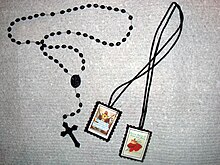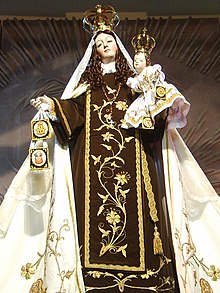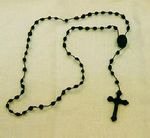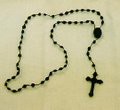Rosary and scapular

The topic of this article may not meet Wikipedia's general notability guideline. (August 2022) |
The exact origins of both the rosary and scapular are subject to debate among scholars. Pious tradition maintains that both the rosary and the brown Scapular of Our Lady of Mount Carmel were given by the Virgin Mary to Dominic and Simon Stock respectively during the 13th century.[1] Historical records document their growth during the 16th and 17th centuries in Europe. By the early 20th century, they had gained such a strong following among Catholics worldwide that Josef Hilgers, writing in the Catholic Encyclopedia of 1914, stated: "Like the Rosary, the Brown scapular has become the badge of the devout Catholic."[2]
Since the Second Vatican Council, the more appropriate term for these items is "devotional articles", in order to distinguish them from liturgical actions and items used therewith, such as candles, chrism, or sprinkling with holy water.[3]
As with all religious articles, the use of the
Devotions

The rosary and the scapular are viewed as devotional elements of Catholicism. However, although many of the faithful choose to pray the rosary and wear the scapular, the linking of the rosary and the scapular is not formally reflected in church doctrine.
Traditional accounts
Dominic
According to the tradition of the Dominicans, the rosary was given to
Simon Stock

Like the purported vision of Mary to Dominic, the earliest mention of Simon Stock's vision comes over 100 years later, and there is a lack of documentary evidence that would demonstrate the truth or historicity of the apparition. While Richard Copsey questioned the fact that any apparition took place with respect to the scapular,[10] Although the historicity of the scapular vision is disputed, the scapular itself has remained for all Carmelites a sign of Mary's motherly protection and as a personal commitment to follow Jesus in the footsteps of his Mother, the perfect model for all his disciples.
Historical developments
Sacramental garments |
| General |
|---|
| Specific scapulars |
|
|
Catholicism portal |
Confraternities
The beginning of the 18th century witnessed a significant growth in Marian confraternities, such as the
The approval of the "Confraternity of the Scapular" for every diocese helped the spread of that devotion, reaching its culmination in 1726 via the extension of the
Marian apparitions
In the 19th century, the reported Marian apparitions of Our Lady of Lourdes gathered significant attention, and provided momentum for the spread of the rosary. The spread of the devotion to both the rosary and the scapular was influenced by Marian apparitions of Our Lady of Fátima reported by three Portuguese children in 1917.[14] The Fatima messages placed a strong emphasis on the rosary, and in them the Virgin Mary reportedly identified herself as The Lady of the Rosary.[15] The visions and messages also encouraged the wearing of the Brown Scapular. In the final Fátima appearance on 13 October 1917, the Virgin Mary had a brown scapular in one hand and a rosary in the other.[16]
Associations
The 20th century witnessed the development of a number of Marian organizations. The
Mariology
Papal endorsements
Leo XIII dedicated the human race to the
Role of the saints
Louis de Montfort is widely known for his promotion of the rosary. Montfort developed specific methods of praying the rosary to help the meditative process and emphasized the need for purity of intention, attention and reverence in prayers.[28][29] [30][31]
Meditative basis
Saints and popes have emphasized the
Although Pope John Paul II is best known for his devotion to the rosary, he stated that he viewed the scapular as a "habit" to orient one's Christian life: "The sign of the Scapular points to an effective synthesis of Marian spirituality, which nourishes the devotion of believers and makes them sensitive to the Virgin Mother's loving presence in their lives. ...Devotion to her cannot be limited to prayers and tributes in her honor on certain occasions, but must become a 'habit', that is, a permanent orientation of one's own Christian conduct."[34]
The wearing of a scapular has been viewed as constant meditation by Bishop Leo De Goesbriand: "Wherever I am, whatever I am doing, Mary never sees me without seeing upon my body an evidence of my devotion to her."[35]
From a venerative viewpoint, Etienne Richer points out the rosary and the scapular as the key devotions that harmonize with Catholic Liturgy in the meditative process of the
The Rosary and the devotional scapular continue to be linked in the 21st century.[37]
Gallery
-
A simple Rosary
-
Various rosaries with Crucifixes
-
TheBrown Scapular of Our Lady of Mount Carmel
See also
Notes
| Part of a series on the |
| Rosary of the Catholic Church |
|---|
 |
| Overview |
| Prayers and promises |
|
| Writings |
| People and societies |
|
|
Catholicism portal |
- ^ Saunders, William. "History of the Rosary", The Arlington Catholic Herald, October 6, 1994
- ^ "Scapular", The Catholic Encyclopedia, Vol. 13, New York: Robert Appleton Company, 1912. 22 Dec. 2014.
- ^ Catechism of the Catholic Church §1674
- Apostolic Constitution Indulgentiarum Doctrina [1]
- ^ "CATHOLIC ENCYCLOPEDIA: The Rosary". www.newadvent.org. Retrieved 2020-04-11.
- ISBN 978-0-271-01631-3p. 72
- ISBN 1-60506-312-6p. 65
- ISBN 978-1-59276-441-9page 155
- ^ Most, William. "The Brown Scapular", EWTN
- ^ Copsey, Richard. Simon Stock and the Scapular Vision, The Journal of Ecclesiastical History, 50:4:652–683, 1999
- ^ "CATHOLIC ENCYCLOPEDIA: Confraternity of the Holy Rosary". www.newadvent.org. Retrieved 2020-04-11.
- ISBN 1-4021-6108-5p. 498
- ISBN 0-521-78044-6page 145
- ^ de Marchi, John. The True Story of Fatima, Catechetical Guild Educational Society, St. Paul, Minnesota, 1952
- ISBN 978-1-59276-026-8p. 348
- ISBN 0-911218-10-6
- ISBN 978-0-87973-390-2page 141
- ISBN 1-60136-000-2page 127
- ISBN 0-19-530491-8page 98
- ^ "Supremi Apostolatus Officio (September 1, 1883) | LEO XIII". www.vatican.va. Retrieved 2020-04-11.
- ^ "Octobri Mense (September 22, 1891) | LEO XIII". www.vatican.va. Retrieved 2020-04-11.
- ^ Remigius Baumer, 1988, Marienlexikon, St. Ottilien, pp.41
- ^ "12 September 2001 | John Paul II". www.vatican.va. Retrieved 2020-04-11.
- ISBN 978-0-385-40966-7page 28
- ^ Lo Scapolare del Carmelo Published by Shalom, 2005
ISBN 88-8404-081-7page 6
- ISBN 978-0-87973-701-6page 162
- ISBN 978-0-89870-682-6
- ISBN 978-1-58051-077-6page 4
- ISBN 978-88-7839-030-0page 7
- ISBN 978-0-87973-852-5page 136
- ISBN 978-0-8308-2595-0page 109
- ISBN 978-1-59276-098-5page 135
- Ingruentium Malorum on the Vatican website [2]
- ^ John Paul II Scapular Message at the Vatican website
- ISBN 978-1-4086-8655-3page 408
- ISBN 1-57918-355-7page 667
- ^ Zenit News 2008 Cardinal Urges Devotion to Rosary and Scapular Archived 2012-11-14 at the Wayback Machine
References
- Garry Wills, 2005, The Rosary, Viking Press, ISBN 0-670-03449-5
- Augusta Drane, 1998, The Life of St. Dominic, TAN Books, ISBN 0-89555-336-8
- Kevin Johnson, 1999, Rosary: Mysteries, Meditations, and the Telling of the Beads Pangaeus Press ISBN 0-9653660-1-4
- John Paul II, 1999, Mysteries of Light, Meditations on the Mysteries of the Rosary Ligouri Publications, ISBN 0-7648-1060-X
- John Paul II, 2002, The Rosary Hour Simon and Schuster, ISBN 0-7434-7061-3




